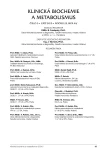-
Medical journals
- Career
Bias měření základních analytů krevního séra.
Výsledky a interpretace soudobých studií.
Authors: B. Friedecký 1,2; J. Kratochvíla 2
Authors‘ workplace: ÚKBD Fakultní nemocnice Hradec Králové 1; SEKK s. r. o. Pardubice, Za Pasáží 2
Published in: Klin. Biochem. Metab., 23 (44), 2015, No. 3, p. 105-108
Prostřednictvím měření docházíme k vědění (H. Kamerlingh-Onnes)
Overview
Objective:
Comment of bias values reached in recent results of four commutable reference materials and programs in general blood serum analytes and their comparison with results of EQA program SEKK-AKS in 2012-2014.Methods:
As commutable reference materials were used sets of individual blood donors and non spiked and spiked frozen native serum pools. Bias values were calculated as differences of manufacturer groups means from robust mean of all participants.In some cases were used values obtained by reference methods.
Results, discussion: Majority of bias values did not exceeded 4 %. No significant dependency on the on the kind of matrix was observed. Some large bias values were observed only exceptionally in some methods of uric acid and phosphate.Measurement of albumin was influenced by differences between BCG and BCP methods, higher concentration of triglycerides is reason of large bias in HDL and LDL method. Commonly are bias values higher than requested, from biological variations derived. No significant matrix influence on the bias value was observed in measurement of general blood serum analyzed. We think that ex post commutability evaluation of EQA program results based on the use standard lyophilized materials can be realized by assessment relation of bias to uncertainty of reference values. There is necessary to prefer reference method values or robust mean values as criterion not only for proficiency of participants and also for monitoring of level in standardization.Keywords:
Standardization, harmonization, bias of measurement, electrolytes, organic substrates.
Sources
1. Van Houcke, S. K., Rustad, P., Stepman, H. C. M., Kristensen, G. B. B., Stöckl, D., Roraas, T. H., Sandberg, S., Thienpont, L. M. Calcium, magnesium, albumin and total protein measurement in serum as assessed with 20 fresh-frozen single donation sera. Clin. Chem., 2012, 58, p. 1597-1599.
2. Stepman, H. C. H., Tiikkainen, U., Stöckl, D., Vesper, H. W., Edwards, S. H., Laitinen, H., Pelanti, J., Thienpont, L. M. et al. Measurements for 8 common analytes in native sera identifies inadequate standardi-zation among 6 routine laboratory assays. Clin. Chem., 2014, 60, p. 855-863.
3. De Grande, L. A. C., Goossens, K., Van Uytphange, K., Stöckl, D., Thienpont, L. M. The Empower project - a new way of assessing and monitoring test comparability and stability. Clin. Chem. Lab. Med., DOI 1515/cclm-2014-0959.
4. CLSI. Characterization and quantification of commutable reference materials for laboratory medicine-approved guideline. CLSI document C 53-A. Wayne 2010.
5. Koerbin, G., Tate, J. R., Ryan, J., Jones, G. R., Sikaris, K. et al. Bias assessment of general chemistry analytes using commutable samples. Clin. Biochem., 2014, 35, p. 203-211
6. Vesper, H. W., Wilson, P. W. F., Rifai, N. A message from the laboratory community to the National Cholesterol Education Program Adult Treatment Panel IV. Clin. Chem., 2012, 58, p. 523-527.
7. Killen, A. A., Ashwood, E. R., Ventura, C. B., Styer, P. Recent trends in performance and current state of creatinine assays. Arch. Pathol. Lab. Med., 2013, 137, p. 496-502.
8. Friedecký, B., Kratochvíla, J. harmonizace výsledků měření-trend světové laboratorní medicíny. Jaký bude dopad v české laboratorní medicíně. FONS 2/2015
Labels
Clinical biochemistry Nuclear medicine Nutritive therapist
Article was published inClinical Biochemistry and Metabolism

2015 Issue 3-
All articles in this issue
- Presepsin as a diagnostic and prognostic tool for sepsis
- The use of soluble cytokeratin fragments in the diagnosis of liver metastases.
- Monitoring of DNA methylation in ovarian cancer using microarrays.
-
Bias měření základních analytů krevního séra.
Výsledky a interpretace soudobých studií. - The permissible limits for intermediate precision in control charts
- Appreciation
- Program of lecture blocks
- List of posters
- Abstract of lectures
- Abstract of posters
- Index of the authors of abstracts
- Clinical Biochemistry and Metabolism
- Journal archive
- Current issue
- Online only
- About the journal
Most read in this issue- Presepsin as a diagnostic and prognostic tool for sepsis
-
Bias měření základních analytů krevního séra.
Výsledky a interpretace soudobých studií. - Abstract of posters
- The permissible limits for intermediate precision in control charts
Login#ADS_BOTTOM_SCRIPTS#Forgotten passwordEnter the email address that you registered with. We will send you instructions on how to set a new password.
- Career

